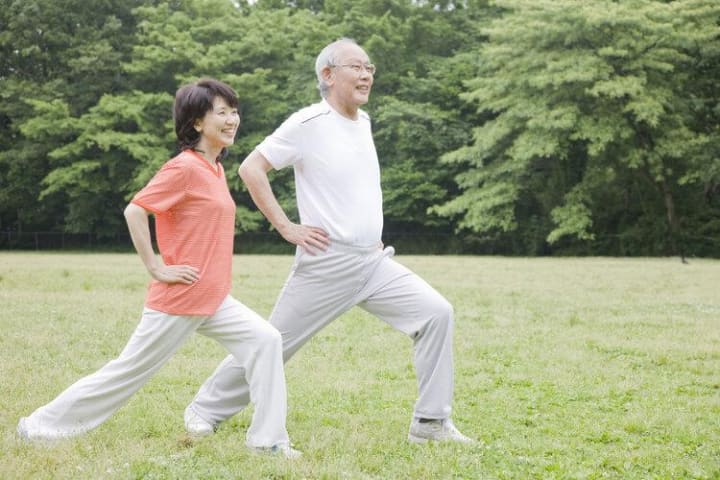
In recent years, the concept of health care has gained popularity. National sports have become a craze, and more and more people are beginning to do physical exercise. Not only students and young people, but also many middle-aged and elderly people have joined the sports team.
Everyone says that walking, brisk walking, swimming, and other activities are especially suitable for the elderly, mild and not harmful, but the premise of health is moderate, otherwise, it may be counterproductive.
Do not believe? Let's take a look at their stories.
Ms. Li's weight rose 20 pounds after 2 years at work with the same blow. This year she really can not stand her fat, determined to begin to exercise. Every day after work, she will walk inside the community to brush the number of steps, from the beginning of the daily 10,000 steps gradually increased to 20,000.
After exercising for a while, she found discomfort in her knees and was diagnosed with synovitis after going to the hospital for a checkup.

The same thing happened to Ms. Wu, after retirement she joined the community walking team, and at the beginning, it was very hard to follow the team. But she gritted her teeth and persevered for a month, and gradually kept pace with the large team, with a daily step count of nearly 20,000 steps.
After 2 months of walking, Ms. Wu got up one morning and found that she could barely stand on her knees and could not walk on her own, so she went to the hospital and was diagnosed with synovitis.
Auntie Chen after retirement nothing to do, with a group of old friends organized a walking team, when the team set the number of steps is 3000 steps per day, later she found that the number of steps in the circle of friends is more than 10,000 steps.
Defiantly, she decided to keep up the pace and increased her walking volume. After a while, Auntie Chen found that her right leg was a bit deformed, and her daily walking was a bit overwhelming. She went to the hospital and found that she had osteoarthritis of the knee and needed a joint replacement.
We often hear the saying that walking is good for health, so why are these stories saying that walking has led to disease, walking, in the end, is good.
First, often walking, in the end, is good? Or can reap 5 benefits
The medical journal "BMJ" has published a study, which was conducted by researchers from the University of Cambridge, England. The researchers investigated 14,599 subjects with an average age of 40 to 79 years old and evaluated the relationship between physical activity and mortality, respectively.
The results found that long-term exercise was associated with a decreased risk of death, such that people who walked for 20 minutes a day prevented 46 percent of potential deaths.
In addition to this, regular walking can bring these health benefits
Exercises the heart: During walking, promotes enhanced cardiovascular function and allows the body to circulate blood faster. It is beneficial for preventing heart disease and lowering blood pressure.
Promote digestion: walking is a relatively soothing exercise, but the process of exercise can also promote gastrointestinal peristalsis, some people with indigestion, and constipation phenomenon, can play a certain relief through walking.
Strong bones: the United States Brigham and Women's Medical has conducted an epidemiological survey that found that middle-aged men walking a short time a day, and the risk of fracture after the age of 50 decreased, especially hip fractures.
Promote weight loss: Walking allows the body's muscles to be active, which in turn burns excess blood sugar and reduces the rise in blood fats after meals. Fat synthesis in the body is also reduced, which has good benefits for weight control.
Reduce the risk of respiratory disease: A Spanish study found that a daily walk of 3KM can play a preventive role in the occurrence of respiratory diseases. Even some patients who have already suffered from respiratory diseases can also promote recovery by walking.
It is worth reminding that walking is good, but we should pay attention to the right amount, too much walking every day can bring great harm to the knee. During walking, the cartilage of our knee joints is constantly rubbed, which can lead to inflammation and edema.
And our knee joint has a life span, long-term excessive exercise will overdraw the knee joint, resulting in aging and early functional degeneration.

Second, how many steps a day is the best? Research tells you the answer
Professor Hu Yang, director of the Scientific Research Center of Beijing Sports University, conducted a survey that found that people who walked 14km per week had a 40% lower risk of cardiovascular disease compared to those who walked <4km. This translates into a daily walk of about 7,500 steps.
However, there are different ways to exercise for different age groups. After the age of 60 to 70, there will be different degrees of degeneration of various body functions, so it is not recommended for the elderly to go for a brisk walk.
At this stage of life, the elderly should walk at an even pace and make adjustments according to their physical conditions, or reduce the number of steps per day. The Dietary Guidelines for Chinese Residents recommends that the number of steps per day is kept at 6,000.
The amount of daily exercise must be controlled, too much exercise can bring health risks. When exercising, choose a safe place and appropriate posture, it is not recommended for the elderly to walk backward and in other postures that are more demanding on the body.
It is also important not to eat a lot of food before exercise, and to pay attention not to drink a lot of water after exercise, but to drink slowly in small sips. Some elderly people with underlying diseases need to pay more attention when exercising, it is best to consult a professional doctor's advice before considering exercise.
Third, the correct walk is much, after 60 years old, when walking to remember 4 points
For the elderly, exercise must do these four things to avoid improper ways to bring threats to their health.
1. walking posture should be correct
When walking keep your head up and chest up so that the whole body's meridians and blood vessels are followed by the activity. The posture of hunching over the chest will lead to the body's oxygen supply being affected, easy to make people overly fatigued, and tense, for health is not good. 2.
2. grasp the amount of walking exercise
The amount of exercise is a very important point, exercise must be suitable for the body to the extent of the standard. When you feel particularly fatigued in the process of exercise or joint pain has appeared, you must promptly stop exercise.
3. don't wear shoes that don't fit your feet
Walking is recommended to wear shoes suitable for running, such shoes can play a certain role in cushioning, reducing the pressure on the knee and foot. Once wearing unsuitable shoes, it is easy to cause sports injuries in the process of exercise.
4. don't walk on the side of the road
Roadside is a more serious environmental pollution, it is recommended that walking do not choose in this place. Instead, choose parks, playgrounds, woods, neighborhoods, and other relatively safe, less polluted places, the elderly walking is best accompanied by someone to avoid accidents.
Fourth, walking after meals can improve health, but unfortunately, there are 5 types of people who can not walk
Exercise after meals is what a lot of people are doing, but this thing is not suitable for all, of these five types of people, daily to avoid walking after meals.
First of all, for people with gastroptosis, walking after meals, then easily lead to an increased gastrointestinal burden, making the condition more serious.
Anemia is low blood pressure people can not walk after meals, because after meals, a large amount of blood in our body is concentrated in the stomach for digestion, walking at this time is easy to lead to cerebral ischemia, causing dizziness symptoms to appear;

Some patients who have chronic gastritis, or peptic ulcer can not walk after meals, otherwise, it is not conducive to the repair of the gastric mucosa; For hypertension, and diabetes patients walking immediately after meals are likely to cause postural hypotension, to avoid as far as possible;
There are also people suffering from coronary heart disease, angina, and other heart diseases, walking immediately after meals is likely to induce heart attacks and angina.
Walking is a good exercise for most people, but some people are not suitable for this exercise, before the exercise we need to clarify whether they are suitable, and at the same time pay attention to the exercise precautions, to avoid the adverse effects of exercise on the body.
About the Creator
Tanoria
no rose without a thorn.






Comments
There are no comments for this story
Be the first to respond and start the conversation.